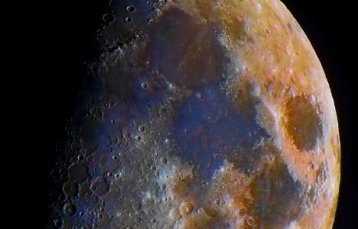 Did you sleep through the auroras of Dec. 14th? Next time get a wake-up call: Spaceweather PHONE.
Did you sleep through the auroras of Dec. 14th? Next time get a wake-up call: Spaceweather PHONE.
SNOW MOON: According to folklore, tonight's full moon is the Snow Moon. February moonlight floods the snowy terrain of the north, making the night unusually bright. Step outside and enjoy the view!
NOT SO GRAY: At first glance, the moon looks remarkably gray. There are light-gray lunar highlands, dark-gray lunar seas, and miles and miles of gray moondust everywhere. Not so fast! Astronomers have long known that the moon's terrain is actually rich in subtle color. Consider this Jan 27th image from astronomer Mohammad Shirani of the United Arab Emirates:

Photo details: Canon EOS 350D, 8-inch Vixen R200, ISO 400, ~0.1 sec,
"I didn't use any filters to create this image," says Shirani. He didn't need to. The colors are naturally present and only need a bit of processing with Photoshop to see. "The method is described here."
What do these colors mean? Blue denotes areas rich in titanium, while orange is titanium poor. Pink traces iron-poor, aluminum-rich feldspars found in the lunar highlands. A challenge to astrophotographers: Capture the colors of tonight's Snow Moon. It's not as gray as you think.
COMET MCNAUGHT: Is it a hallucination? A painting by Dali? Bad science fiction?
None of the above. This is a real photo of Comet McNaught and the Southern Lights:

Photo details: Pentax *ist Ds, Sigma 15mm / Takumar 28mm, ISO800, 120s
Minoru Yoneto of Queenstown, New Zealand took the picture on Jan. 30th shortly after a solar wind stream hit Earth, triggering a strong geomagnetic storm. "The comet lost its tail among the auroras," says Yoneto.
Comet McNaught is receding from Earth and fading, but it is still an easy target for photographers in the Southern Hemisphere. Exposures as short as 20 seconds produce spectacular results: finder chart.
Comet McNaught Photo Gallery
[ephemeris] [3D orbit] [comet camera]

